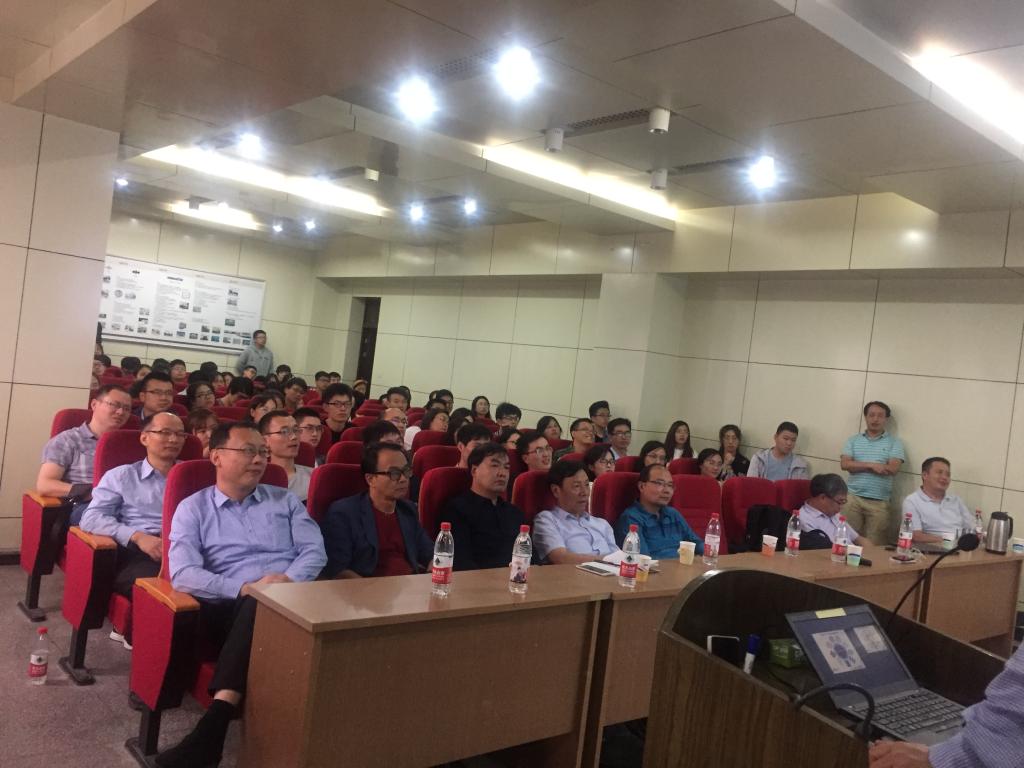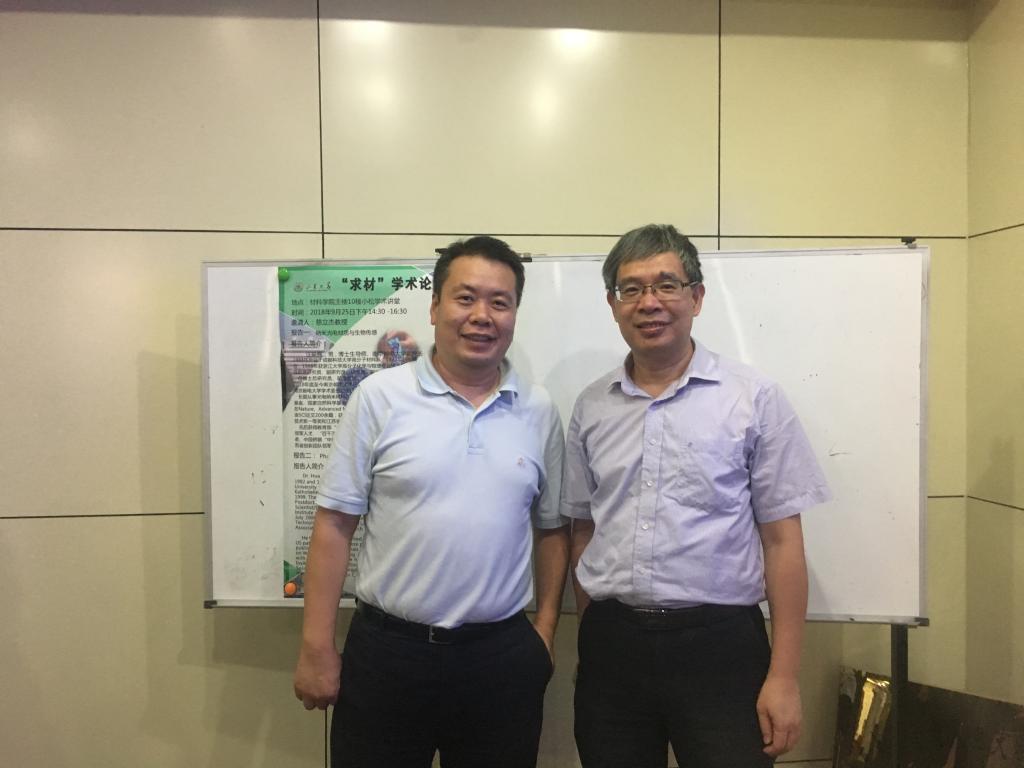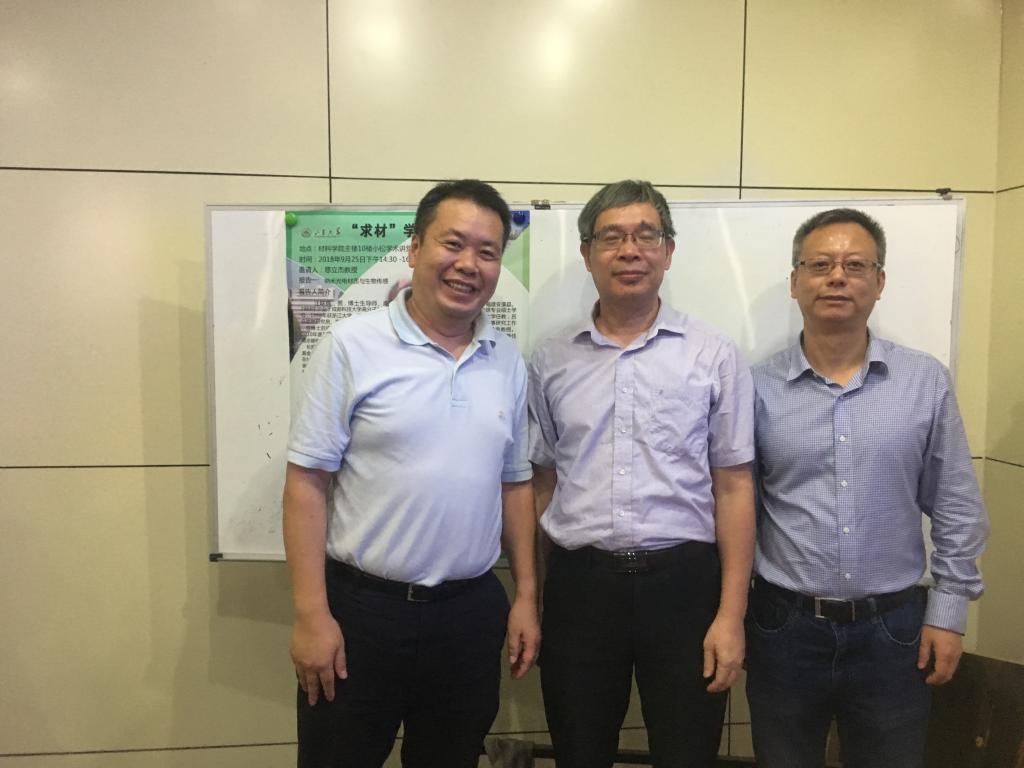9月25日下午14:30,材料科学与工程学院在千佛山校区主楼十楼小松会议室举办“求材”学术论坛。此次论坛由山东大学研究生院与党委研究生工作部共同主办,材料科学与工程学院承办。论坛邀请了汪联辉教授和张华教授分别作了题为“纳米光电材质与生物传感”、“Phase Engineering of Novel Nanomaterials”的报告。材料学院慈立杰老师、闵光辉老师、李辉老师等出席此次论坛。

汪联辉首先从背景介绍开始,他说道,全球癌症患者的发病率和死亡率的居高不下其主要原因就是癌细胞检测技术的不成熟,基于这一背景,他提出了三种可能解决方案:(1)高灵敏度检测技术、(2)超高灵敏度检测技术、(3)联合检测技术。然后,汪联辉介绍了两种生物检测方法和他们课题组取得的成果,分别为:基于金属纳米材料的生物检测和基于二维纳米材料的生物检测。他讲到,纳米光电技术作为解决肿瘤早期检测的关键技术,主要有荧光量子点纳米结构、表面等离子共振纳米结构、二维纳米材料和微流控芯片等方法,可以更好的解决肿瘤早期检测问题。

张华首先为大家展示了一张元素周期表,我们所做的所有实验都是对元素周期表的调控,张华说:“材料人就要做材料,做独特的材料”。他告诫同学们,搞科研要懂得转换思维,一种材料目前的应用可能不是最好的应用,要善于去挖掘。最后,他提出8种新型的纳米材料:(1)石墨烯和杂化纳米材料、(2)超薄贵金属纳米材料、(3)过渡金属二硫化物(TMDs)、(4)金属硫化物薄纳米材料、(5)自组装薄纳米材料、(6)二维金属有机骨架(MOF),共价有机骨架(COF),钙钛矿纳米片、(7)TMD和黑磷纳米点、(8)异质结构的外延生长,供与会师生参考。张华用幽默的方式为大家带来了一场别开生面的报告。
汪联辉教授和张华教授的精彩报告赢得同学们阵阵掌声,报告结束后,与会师生和报告人热烈讨论,学术氛围十分浓厚,大家都感到受益匪浅。

报告人简介:
汪联辉
教授、博士生导师、南京邮电大学副校长,1964 年12月出生于福建安溪县。1988 年毕业于成都科技大学高分子材料系,1993 年获福建师范大学高分子化学与物理专业硕士学位,1998 年获浙江大学高分子化学与物理专业博士学位。1988-2005 年在福建师范大学任教,历任助理研究员、副研究员、研究员、副所长,期间 1998-2005 年赴新加坡国立大学从事研究工作,任博士后研究员、助理教授。2005 年回国受聘复旦大学,任复旦大学先进材料实验室教授。2010 年底至今南京邮电大学任教,先后任材料科学与工程学院院长、研究生院常务副院长并兼任南京邮电大学学术委员会主任,“长江学者”特聘教授。2017 年 4 月任南京邮电大学副校长。
长期从事光电纳米材料、生物光电子学、纳米生物医学等领域教学科研工作。主持国家杰出青年基金、国家自然科学基金重点项目、国家重大科学研究计划项目等 30 多项国内和国际科研项目。在 Nature、Advanced Materials、J Am Chem Soc、Angew Chem Int Ed 等著名学术期刊上发表 SCI 论文 200 余篇;获授权中国和美国发明专利 20 余件;部分研究成果获中国分析测试协会科学技术奖一等奖和江苏省科学技术奖二等奖。
先后获得教育部“长江学者奖励计划”特聘教授、国家杰出青年科学基金获得者、“万人计划”领军人才、“百千万人才工程”国家级人选、国家“有突出贡献中青年专家”、全国优秀科技工作者、中国侨联“中国侨界贡献奖”、教育部“长江学者和创新团队发展计划”创新团队带头人、江苏省创新团队领军人才、江苏省“333 高层次人才工程”首席科学家等称号。
Hua Zhang
Dr. Hua Zhang obtained his B.S. and M.S. degrees at Nanjing University in China in 1992 and 1995, respectively, and completed his Ph.D. with Prof. Zhongfan Liu at Peking University in China in July 1998. He joined Prof. Frans C. De Schryver’s group at Katholieke Universiteit Leuven (KULeuven) in Belgium as a Research Associate in January 1999. Then he moved to Prof. Chad A. Mirkin’s group at Northwestern University as a Postdoctoral Fellow in July 2001. He started to work at NanoInk Inc. (USA) as a Research Scientist/Chemist in August 2003. After that, he worked as a Senior Research Scientist at Institute of Bioengineering and Nanotechnology in Singapore from November 2005 to July 2006. Then he joined the School of Materials Science and Engineering in Nanyang Technological University (NTU) as an Assistant Professor. He was promoted to a tenured Associate Professor on March 1, 2011, and Full Professor on Sept. 1, 2013.
He has published 5 invited book chapters, 72 patent applications (including 8 granted US patents and 1 Singapore patent), and over 450 papers, among which 201 papers were published in IF>10 journals and 103 papers were published in 8<IF<10 journals. Some of his papers have been published in Science (1), Nat. Chem. (5), Nat. Catal. (1), Nat. Rev. Mater. (2), Nat. Commun. (8), Sci. Adv. (1), Nat. Protocols (1), Chem. Rev. (2), Chem. Soc. Rev. (12), Acc. Chem. Res. (2), J. Am. Chem. Soc. (15), Angew. Chem. Int. Ed. (28), Adv. Mater. (51), Chem (1), Energy Environ. Sci (12), Mater. Today (1), Adv. Energy Mater. (6), ACS Nano (28), Nano Lett. (14), Adv. Funct. Mater. (4), Nano Energy (4), Mat. Horizons (2), ACS Catal. (1), etc. Based on Web of Science on Aug. 26, 2018, the total citation times of his papers are over 50,560 with H-index of 111. He has been invited to give more than 300 Plenary, Keynote or Invited Talks in international conferences, universities and institutes, and serve as the Session Chair. He has organized several tens of international conferences and served as the Symposium Chair or Conference Co-Chair. He is one of three Chairmen of the Editorial Board of ChemNanoMat (2015-), sits on the Advisory Board of Chem. Soc. Rev. (2012-), NPG Asia Materials (2018-), Nanoscale (2012-), Nanoscale Horizons (2015-) and Materials Chemistry Frontiers (2016-), the Editorial Advisory Board of ACS Nano (2014-), Chem. Mater. (2014-), ACS Appl. Mater. Interfaces (2014-), Small (2012-), and Nanofabrication (2012-), the Editorial Board of CHEM (2016-), Carbon (2013-), Applied Materials Today (2015-), Energy Storage Materials (2015-), EnergyChem (2018-), ACS Omega (2016-), Materials Today Energy (2016-), npj 2D Materials and Applications (2016-), NANO (2007-), Chinese Science Bulletin (2014-), Science China Materials (2014-) and Graphene Technology (2016-), and the International Advisory Board of Materials Research Express (2014-) and ChemPlusChem (2012-2015). He is also one of the members of the Advisory Committee of IOP Asia-Pacific (2010-). In 2015, he was elected as an Academician of the Asia Pacific Academy of Materials (APAM). In Nov. 2014, he was elected as a Fellow of the Royal Society of Chemistry (FRSC). In 2016, he was listed in the top 300 most cited researchers in the field of materials science and engineering (Elsevier Scopus). In 2017, he was listed in the "Highly Cited Researchers 2017" in Chemistry and Materials Science (Thomson Reuters, 2017). In 2016, he was listed in the "Highly Cited Researchers 2016" in Chemistry and Materials Science (Thomson Reuters, 2016). In 2015, he was listed in the "Highly Cited Researchers 2015" in Chemistry and Materials Science, and also listed as one of 19 “Hottest Researchers of Today” in the world in the World’s Most Influential Scientific Minds 2015 (Thomson Reuters, 2015). In 2014, he was listed in the "Highly Cited Researchers 2014" in Materials Science, and also listed as one of 17 “Hottest Researchers of Today” and No. 1 in Materials and More in the world in the World’s Most Influential Scientific Minds 2014 (Thomson Reuters, 2014). Moreover, he got the Young Investigator Award (Young Giants of Nanoscience 2016, Hong Kong), Vice-Chancellor’s International Scholar Award (University of Wollongong, Australia, 2016), ACS Nano Lectureship Award (2015), World Cultural Council (WCC) Special Recognition Award (2013), the ONASSIA Foundation Lectureship (Greece, 2013), Asian Rising Stars (15th Asian Chemical Congress, 2013), SMALL Young Innovator Award (Wiley-VCH, 2012) and Nanyang Award for Research Excellence (2011).
Dr. Zhang’s research is highly interdisciplinary. His current research interests focus on the (crystal-)phase engineering of nanomaterials and controlled epitaxial growth of heterostructures, including the synthesis of ultrathin two-dimensional nanomaterials (e.g. metal nanosheets, graphene, metal dichalcogenides, metal-organic frameworks, covalent organic frameworks, etc.), novel metallic and semiconducting nanomaterials, novel amorphous nanomaterials and their hybrid composites, for various applications such as catalysis, clean energy, (opto-)electronic devices, nano- and biosensors, and water remediation.